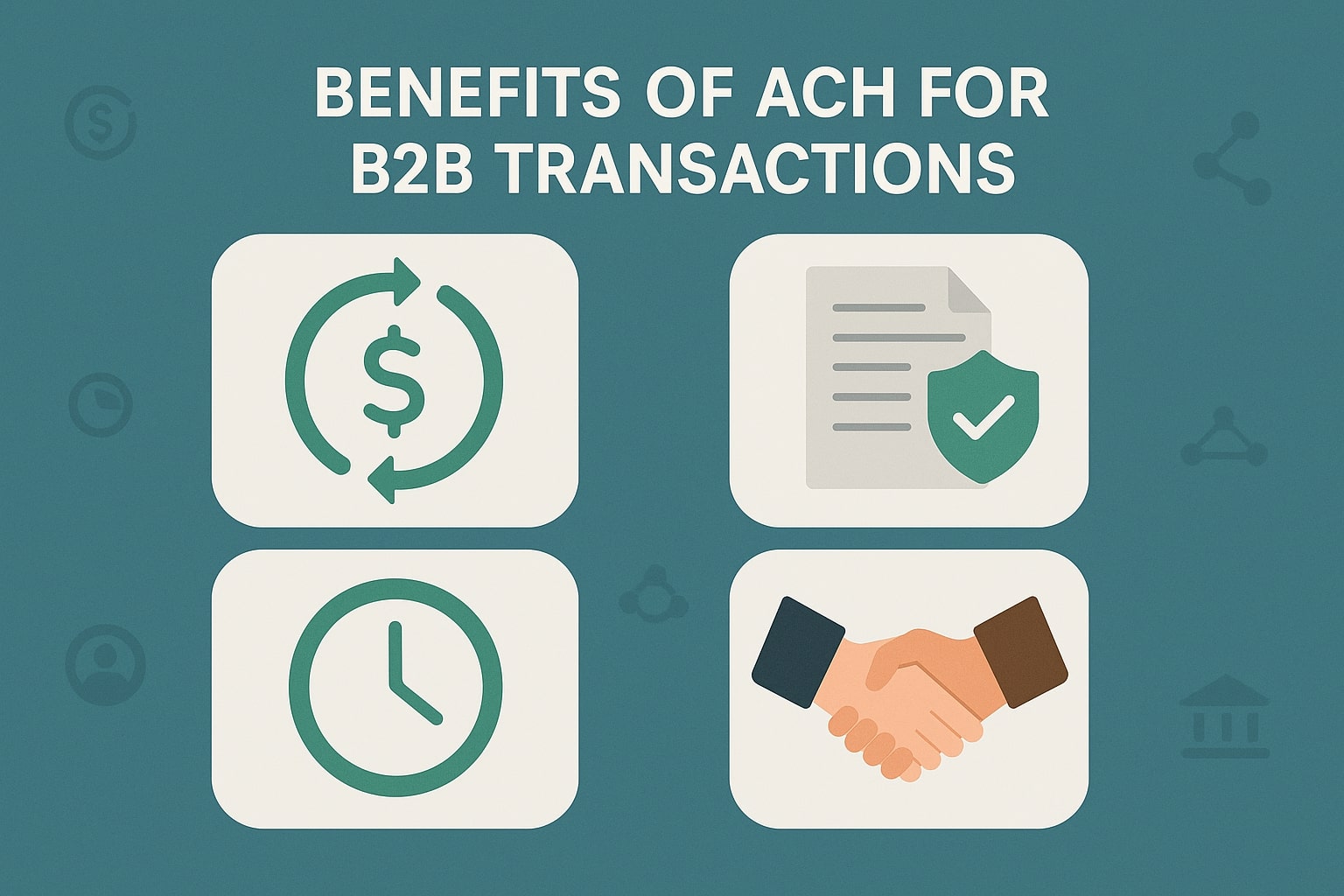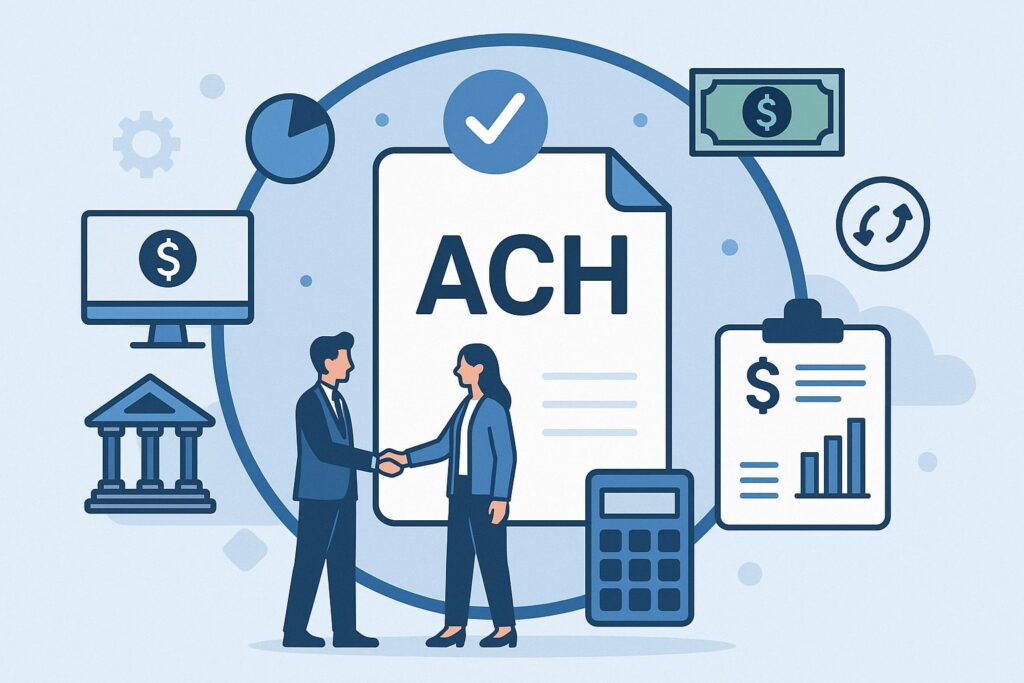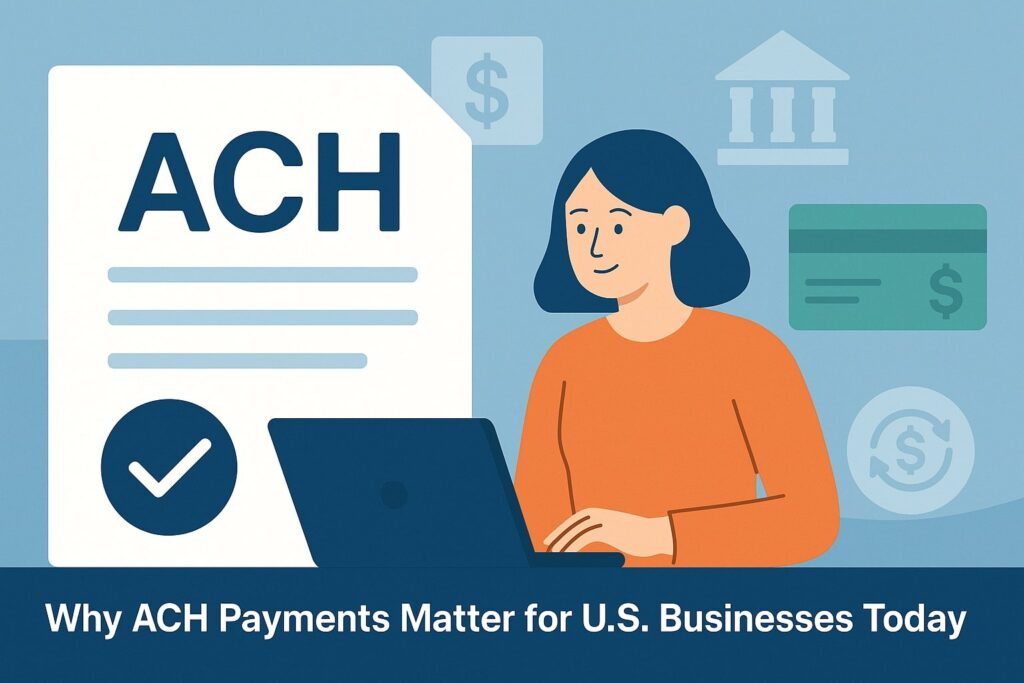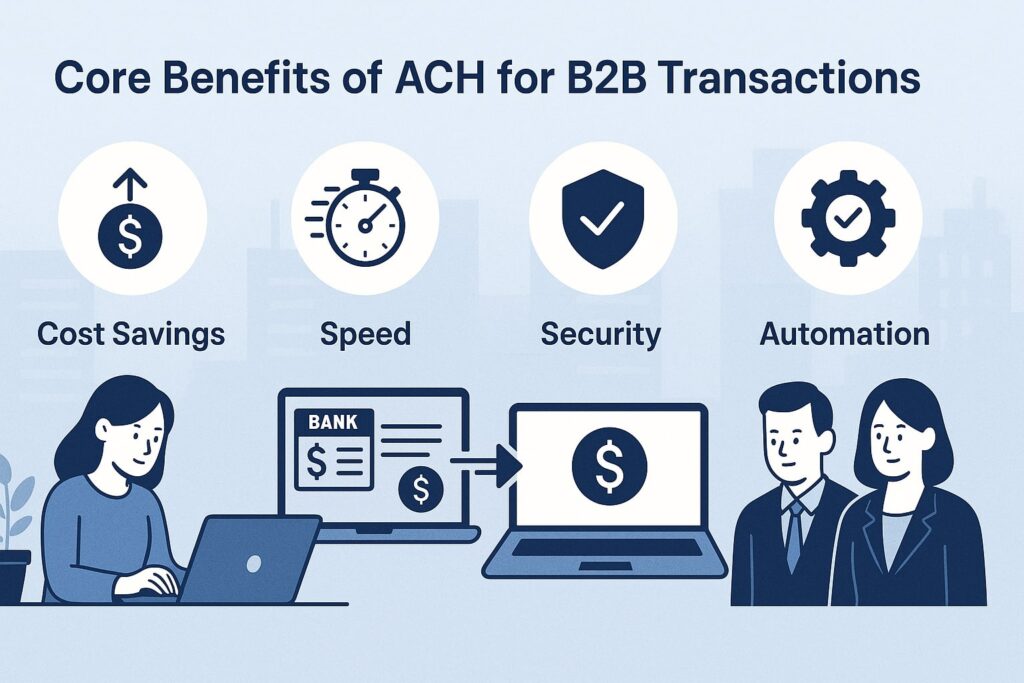
By achforbusiness October 21, 2025
ACH for B2B transactions has become the quiet workhorse of U.S. business payments. Companies rely on Automated Clearing House rails to move money directly between bank accounts with lower costs, dependable timing, and better data than checks.
When you modernize payables and receivables with ACH for B2B transactions, you reduce friction across cash flow, reconciliation, and vendor relationships.
This updated guide explains how ACH payments work for U.S. businesses, the core benefits of ACH for B2B transactions, where ACH fits alongside wires and cards, and the practical steps to implement ACH processing at scale.
You’ll also learn best practices for security, compliance, and remittance data so your accounting team can post payments automatically and your partners get paid on time. Throughout, we’ll keep the language clear and the advice actionable so your team can quickly capture the benefits of ACH for B2B transactions without guesswork.
What Is ACH for B2B Transactions?

ACH for B2B transactions uses the U.S. Automated Clearing House network to credit or debit corporate bank accounts for invoices, subscriptions, retainers, or payroll reimbursements.
Instead of printing checks or asking vendors to key card numbers, your company authorizes an electronic ACH entry that moves funds account-to-account. In practice, the process starts in your ERP, AP automation platform, or bank portal.
You create a payment file (often CCD for corporate credits or CTX when you need more remittance details), schedule a date, and transmit the file through your bank or payment processor. The receiving bank posts the funds, and your vendor sees the payment and remittance in their statement or import file.
Because ACH for B2B transactions rides batch rails, it is optimized for high-volume, mid-value payments with predictable settlement windows. ACH credits push money to suppliers, contractors, and landlords.
ACH debits pull money from customers who authorize you to collect on due dates. Compared to wires, ACH is cheaper and easier to automate. Compared to checks, ACH eliminates printing, postage, lockbox delays, and manual posting.
And compared to cards, ACH avoids interchange and chargebacks while supporting richer addenda records for reconciliation. For most U.S. businesses, the benefits of ACH for B2B transactions show up immediately in operating expense, cycle time, and financial control.
Why ACH Payments Matter for U.S. Businesses Today

The benefits of ACH for B2B transactions map directly to today’s operating pressures: remote workflows, supplier diversification, and cash-flow certainty. Paper checks strain hybrid AP teams, create fraud risk in the mail, and delay vendor satisfaction.
Card payments may be fast, but interchange fees erode margins and card limits don’t always fit enterprise invoices. ACH hits the sweet spot: predictable timing, low per-payment cost, and automation-ready data.
Another reason ACH for B2B transactions matters is ecosystem maturity. Banks, fintech platforms, and ERP vendors now provide turnkey onboarding portals, micro-deposit verification, and tokenized storage for account details.
That cuts implementation risk and accelerates supplier adoption. Meanwhile, NACHA rules have steadily improved verification and risk controls, making ACH safer and more transparent.
When your finance team needs scale without adding headcount, ACH processing lets you centralize approvals, run payment batches, and feed clean data into your general ledger. The outcome is less firefighting, faster closes, and a more professional experience for vendors and customers across the U.S. market.
Core Benefits of ACH for B2B Transactions

The headline benefits of ACH for B2B transactions include cost savings, automation, speed, and control. First, cost: per-item ACH fees are typically a fraction of check printing, postage, and lockbox services, and far below card acceptance or wire fees.
Second, automation: ACH for B2B transactions supports remittance addenda (CCD+ or CTX) so you can pass structured invoice numbers, POs, and credits to drive straight-through reconciliation.
Third, speed and predictability: standard ACH credits settle within one to two business days, and same-day windows enable expedited payout for urgent invoices. Fourth, control: payment scheduling, batching, and approval workflows inside your bank or AP system reduce manual steps and enforce segregation of duties.
Security is another core benefit of ACH for B2B transactions. Because funds move account-to-account, there is no card data to steal and no physical checks to intercept. Positive pay-style controls, account validation tools, and OFAC screening add layers of protection.
Finally, ACH scales: whether you’re paying ten vendors a week or thousands a day, ACH processing handles volume without overwhelming your team. The cumulative effect is a leaner payables and receivables operation with fewer errors, fewer calls from vendors, and less money trapped in transit.
Cash Flow and Working Capital Advantages
ACH for B2B transactions enhances cash flow in two ways: timing and predictability. With checks, payment floats in the mail and clears unpredictably. With wires, cash leaves instantly, which can be overkill.
ACH credits let you schedule settlement on due dates, aligning outflows with cash position. On the receivables side, ACH debits with customer authorization let you collect on the exact day invoices are due, shrinking days sales outstanding and stabilizing forecast accuracy.
The benefits of ACH for B2B transactions also include exception visibility: you get fast notifications of returns, enabling your team to resolve issues before they cascade into write-offs.
Because ACH for B2B transactions is easy to batch, you can consolidate outflows to a few discrete posting windows each week. That reduces idle cash and minimizes overdraft risk.
When combined with early-pay discounts and automated reminders, ACH creates a virtuous cycle—vendors receive funds on time, you capture discounts reliably, and treasury gains clearer sightlines for investments and debt draws.
In tight credit environments, this predictability is a strategic advantage that can be felt across procurement, operations, and finance.
Security, Compliance, and Risk Management
One of the quieter benefits of ACH for B2B transactions is a robust compliance framework. NACHA operating rules govern authorizations, return reason codes, and data security expectations for originators and third-party senders.
Banks conduct OFAC screening, and many processors provide account verification—such as micro-deposits or instant bank authentication—before you send or pull funds.
Because ACH for B2B transactions relies on routing and account numbers, tokenization and encryption safeguard sensitive data at rest and in transit. Role-based access in your ERP or AP automation platform limits who can add beneficiaries, approve batches, and release funds.
Risk management also improves with ACH for B2B transactions due to clear exception workflows. If a debit is returned for insufficient funds or authorization issues, you receive a specific code and can act promptly. Credits rarely bounce when you validate account ownership up front.
Combined with multi-factor authentication, IP allow-listing, and payment limits, ACH for B2B transactions can materially lower fraud exposure versus mailing checks or emailing card details. The overall posture is safer, auditable, and aligned with U.S. regulatory expectations.
Operational Efficiency and Automation
Automation is where the benefits of ACH for B2B transactions really compound. Modern platforms map vendor master data, W-9 collection, bank account verification, and payment preferences into a single workflow.
AP clerks schedule runs, CFOs approve, and the system generates NACHA-compliant files with CCD+ or CTX addenda. On the AR side, you embed “Pay by bank” links, collect authorizations, and create recurring ACH debits for subscriptions or maintenance contracts.
Because ACH for B2B transactions supports rich remittance data, your GL can auto-apply cash to open invoices without manual keystrokes. That slashes reconciliation time at month-end and reduces unapplied cash.
Exception queues handle returns or partial payments, keeping your ledger clean. And since ACH is native to banks and ERPs, you avoid brittle screen-scraping or complex card gateways. The result is a streamlined back office where people manage exceptions while the system handles everything else.
Comparing ACH vs. Wires vs. Checks vs. Cards
To pick the right rail, weigh cost, speed, value, and risk. The benefits of ACH for B2B transactions make ACH the default for routine domestic invoices: low cost, reliable next-day or two-day settlement, and automation-friendly data.
Wires are best for urgent, high-value, one-off transfers where a guaranteed same-day credit is essential—but fees add up and wire details rarely carry structured remittance. Checks are slow, costly, and fraud-prone; they persist mainly where suppliers resist change.
Commercial cards offer rebate opportunities and instant authorization, but interchange and chargebacks can be painful, and posting data may be limited.
In most cases, ACH for B2B transactions wins on total cost of ownership and staff productivity. Run a hybrid strategy: ACH as your standard rail, wires for true emergencies or escrow-style needs, cards for travel or small-ticket spend management, and checks only when a vendor absolutely requires them.
This blended approach maximizes the benefits of ACH for B2B transactions while keeping optionality for edge cases.
Same Day ACH and Real-Time Payments—Where ACH Fits
Same Day ACH adds flexibility to ACH for B2B transactions by offering faster windows and later submission deadlines than traditional batches. Use it for expedited supplier payouts, off-cycle payroll adjustments, or to recover from missed cutoffs.
Meanwhile, real-time payment rails (RTP™ or FedNow®) deliver immediate posting and 24/7/365 availability. They shine for just-in-time disbursements, emergency vendor releases, or payment-upon-delivery workflows.
Even with new instant options, the benefits of ACH for B2B transactions are compelling: broad bank coverage, low fees, and mature tooling.
Many U.S. companies land on a tiered policy—ACH for routine invoices, Same Day ACH for exceptions, and real-time only when business needs the immediacy. This keeps costs predictable without sacrificing responsiveness.
How to Implement ACH for B2B Transactions (Step-by-Step)
1) Define policy and scope. Identify invoices, suppliers, and customers that will move to ACH for B2B transactions. Set approval thresholds, payment calendars, and exception rules.
2) Choose partners. Select your bank and, if helpful, an AP/AR automation platform or payment processor experienced in ACH for B2B transactions. Confirm support for CCD+/CTX addenda and vendor onboarding portals.
3) Collect and verify account data. Use secure forms, micro-deposits, or instant bank auth. Tokenize and encrypt routing and account numbers.
4) Configure ERP and mappings. Enable ACH payment methods, set addenda formats, and map invoice fields to remittance.
5) Pilot with a small vendor set. Run dual processes for a cycle, validate postings, and fine-tune approval paths.
6) Roll out broadly. Communicate benefits of ACH for B2B transactions to vendors—faster pay, fewer lost checks, better remittance. Provide a simple enrollment link.
7) Monitor and optimize. Track return rates, exception causes, cut-off compliance, and same-day usage. Iterate to maximize the benefits of ACH for B2B transactions across the organization.
This structured plan keeps risk low while capturing value quickly.
Pricing Models and Cost Control
Per-item ACH pricing is usually transparent: a flat fee per credit or debit, sometimes with discounts for volume. Some providers bundle ACH for B2B transactions into platform subscriptions, while others offer tiered rates or pass-through bank costs.
There may be fees for returns, addenda lines beyond a threshold, or same-day submissions. Compared to wires and cards, the benefits of ACH for B2B transactions show up in predictable, scalable cost curves—your average cost per $ moved typically drops as volume rises.
To control expenses, standardize on ACH for domestic B2B invoices, use wires only for specific scenarios, and negotiate volume tiers. Reduce exceptions with strong bank verification to avoid return fees.
And use CTX/CCD+ efficiently so you don’t pay for unnecessary addenda padding. When you measure total cost—including staff time and error correction—the benefits of ACH for B2B transactions become even clearer.
ACH Returns, Disputes, and Exceptions
While rare for credits, exceptions can occur in ACH for B2B transactions. Debits may return due to insufficient funds, revoked authorization, or invalid account details. Credits can return if the account is closed or cannot accept that entry type.
Each return comes with a code that explains the issue. Build dashboards to track codes, root causes, and corrective actions. Automate invoice re-presentments or switch a problematic customer from debit to credit until their account stabilizes.
The benefits of ACH for B2B transactions include structured exception handling: you can detect problems quickly, notify stakeholders, and resolve them before month-end.
Ensure your customer authorizations are well documented, your vendor enrollment process validates ownership, and your file formatting matches bank requirements. With those controls, exception rates stay low and predictable.
Compliance Checklist for U.S. Businesses
Compliance underpins the benefits of ACH for B2B transactions. Use this simple checklist:
- Maintain written authorizations for any ACH debits.
- Validate accounts via micro-deposits or instant bank auth before first payment.
- Encrypt and tokenize bank data; limit access via roles.
- Screen payments when required and follow OFAC guidance.
- Use proper SEC codes (CCD for corporate payments, CTX when sending extended remittance, PPD for consumer debits if applicable).
- Monitor return rates and investigate anomalies.
- Keep clear audit trails of approvals and releases.
Following this framework helps you realize the benefits of ACH for B2B transactions while meeting U.S. regulatory expectations and bank due-diligence standards.
Best Practices for Remittance Data and Reconciliation
Rich remittance is the secret sauce behind the benefits of ACH for B2B transactions. Use CCD+ when you need a concise invoice reference, and CTX when suppliers expect multiple invoices or line-item detail in a single payment.
Align your invoice numbers, customer IDs, and PO numbers to fields your suppliers can ingest automatically. On the AR side, publish a remittance format guide to customers so incoming ACH credits include what your system needs to auto-apply.
Standardize naming conventions for payment descriptors so vendors recognize your brand in bank statements. Test end-to-end with your largest suppliers to confirm posting success.
The payoff is true straight-through processing—fewer emails, fewer spreadsheets, and faster closes—one of the most valuable benefits of ACH for B2B transactions.
ACH in Accounts Payable (AP)
In AP, ACH for B2B transactions shortens your invoice-to-pay cycle and reduces manual touches. Start by segmenting vendors: those who can accept CTX for rich data, those fine with CCD+, and the few who need checks.
Offer a self-service portal to capture W-9s, routing/account numbers, and payment preferences securely. Build approval chains by dollar thresholds, and schedule ACH runs on predictable days to stabilize cash planning.
With ACH for B2B transactions, your AP team spends less time printing, stuffing, and chasing lost checks, and more time negotiating terms and discounts. Automated remittance emails and well-structured addenda shrink vendor inquiries.
The combined effect is a professional vendor experience, better control, and measurable savings—exactly the benefits of ACH for B2B transactions your leadership expects.
ACH in Accounts Receivable (AR)
In AR, ACH for B2B transactions accelerates cash collection and improves customer satisfaction. Offer customers recurring ACH debits for subscriptions or maintenance fees, and one-time credits for invoice settlement.
Provide clear authorization language, a secure enrollment flow, and a customer portal for account updates. Map incoming ACH to your lockbox or bank feed and configure auto-application rules in the ERP.
Because the benefits of ACH for B2B transactions include low fees and predictable posting, AR sees lower DSO, fewer disputes, and cleaner aging. Set up automated dunning with “Pay by bank” links to reduce late payments.
For large customers, coordinate remittance formats so their treasury team can automate approvals. When AR and AP on both sides use ACH, the payment lifecycle becomes fast, transparent, and nearly touchless.
Domestic vs. Cross-Border Considerations
ACH for B2B transactions is primarily a U.S. domestic rail. International ACH entries (IAT) exist but involve extra data requirements, bank capabilities, and compliance steps. For true cross-border B2B payments, wires or specialized cross-border platforms are often more suitable, especially when currency conversion is needed.
Many U.S. companies still capture the benefits of ACH for B2B transactions by paying domestic suppliers via ACH and reserving wires for international partners. This split keeps costs low and workflows simple while respecting regulatory boundaries.
If you must pay foreign entities, evaluate treasury solutions that convert currency, comply with local rules, and still feed clean remittance data back to your ERP. Keep domestic ACH for B2B transactions as your baseline, then layer cross-border rails only where necessary.
Future Trends: APIs, Pay-by-Bank, and Real-Time Convergence
The next wave of benefits of ACH for B2B transactions arrives via APIs, dynamic payment requests, and interoperability with instant rails. Bank APIs and modern payment processors expose endpoints for vendor onboarding, account verification, and ACH origination directly from your applications.
“Pay by bank” options are gaining traction in portals and invoices, reducing card costs and speeding settlement. Over time, expect tighter coupling between ACH schedules and real-time confirmations, giving you the cost efficiency of ACH with status visibility approaching instant rails.
Data standards are maturing, too. As more ERPs and platforms adopt structured remittance conventions, straight-through reconciliation will become the norm.
The businesses that lean into ACH for B2B transactions today will be best positioned to extend those benefits into tomorrow’s connected, API-driven finance stack.
Frequently Asked Questions (FAQ)
Q.1: Is ACH safe for high-value B2B payments?
Answer: Yes—ACH for B2B transactions is considered secure when you follow best practices. Data is transferred through regulated banking channels, and NACHA rules govern authorizations and returns.
Use encryption, tokenization, and role-based access to protect routing and account numbers. Implement account validation (micro-deposits or instant bank auth) before sending funds. For high-value payments, add dual approvals and daily limits.
Many companies routinely send five- and six-figure payments via ACH because the benefits of ACH for B2B transactions—low fees, reliable posting, and rich remittance—outweigh perceived risks.
If a supplier requires same-day certainty, consider Same Day ACH submission windows or a wire for that specific case, while keeping standard invoices on ACH to preserve savings.
Q.2: How fast does an ACH B2B payment settle?
Answer: Settlement windows for ACH for B2B transactions are predictable. Standard ACH credits typically post within one to two business days, depending on bank cutoffs and the day/time you submit.
Same Day ACH offers accelerated windows for qualified entries if you meet file deadlines. Many finance teams schedule ACH runs each morning so vendors see funds the next business day, aligning cash outflows with approvals.
The benefits of ACH for B2B transactions also include posting transparency—status messages and return notifications help you track exceptions. For truly immediate needs or after-hours scenarios, real-time rails may fit, but most routine B2B invoices are well served by the predictable cadence of ACH.
Q.3: What remittance formats should we use: CCD+ or CTX?
Answer: Choose based on the remittance detail your trading partners need. CCD+ supports a single, concise addenda record—ideal when one payment corresponds to one invoice.
CTX supports multiple addenda records and is designed for complex remittance—paying multiple invoices, credits, or line-item details in a single transaction. The benefits of ACH for B2B transactions multiply when you and your suppliers agree on a standard that your ERPs can parse automatically.
If your partners can ingest CTX, it enables true straight-through reconciliation; if not, CCD+ with a clear invoice reference still delivers strong results. Document your approach and test end-to-end with key vendors.
Q.4: Do we need customer authorizations for ACH debits?
Answer: Yes. For ACH for B2B transactions, written authorization is essential when you debit a customer’s account. The authorization should describe the amount (fixed or variable), timing, and cancellation process. Keep records readily accessible for audits and dispute resolution.
Use secure enrollment flows, micro-deposits or instant bank auth to verify ownership, and provide advance notice for variable debits. Proper authorization not only satisfies rules but also strengthens trust, reducing disputes and returns.
When you handle authorizations correctly, the benefits of ACH for B2B transactions—lower DSO, predictable cash collection, and fewer payment headaches—are fully realized.
Q.5: How do we drive vendor adoption of ACH?
Answer: Communicate the concrete benefits of ACH for B2B transactions to suppliers: faster payment, no lost checks, and cleaner remittance for easy posting. Make enrollment effortless with a secure portal, guided form fields, and instant bank verification.
Offer early-pay options or net-term improvements contingent on ACH enrollment. Provide sample remittance emails and a posting guide. During rollout, prioritize large vendors first to capture outsized savings, then expand to long-tail suppliers with batch campaigns.
When vendors see funds arrive reliably with clear data, adoption accelerates—and the benefits of ACH for B2B transactions ripple across your entire payables ecosystem.
Conclusion
For U.S. companies, the benefits of ACH for B2B transactions are tangible and compounding: materially lower costs than checks or cards, predictable settlement that stabilizes cash flow, and automation-ready remittance data that unlocks straight-through reconciliation.
ACH for B2B transactions strengthens controls with clear authorization rules, secure account handling, and robust exception codes. It scales from a handful of vendors to enterprise-grade volumes without drowning your finance team in manual work.
Paired with thoughtful policies, modern onboarding, and CTX/CCD+ standards, ACH becomes the default rail for domestic invoices, while wires and real-time payments handle true edge cases.
If your organization is still mailing checks or over-using cards for supplier payments, move ACH to the top of your finance roadmap. Start with a pilot, validate data and cutoffs, then expand rapidly.
The earlier you operationalize ACH for B2B transactions, the sooner you capture savings, accelerate closes, and create a frictionless experience for vendors and customers alike.
Leave a Reply